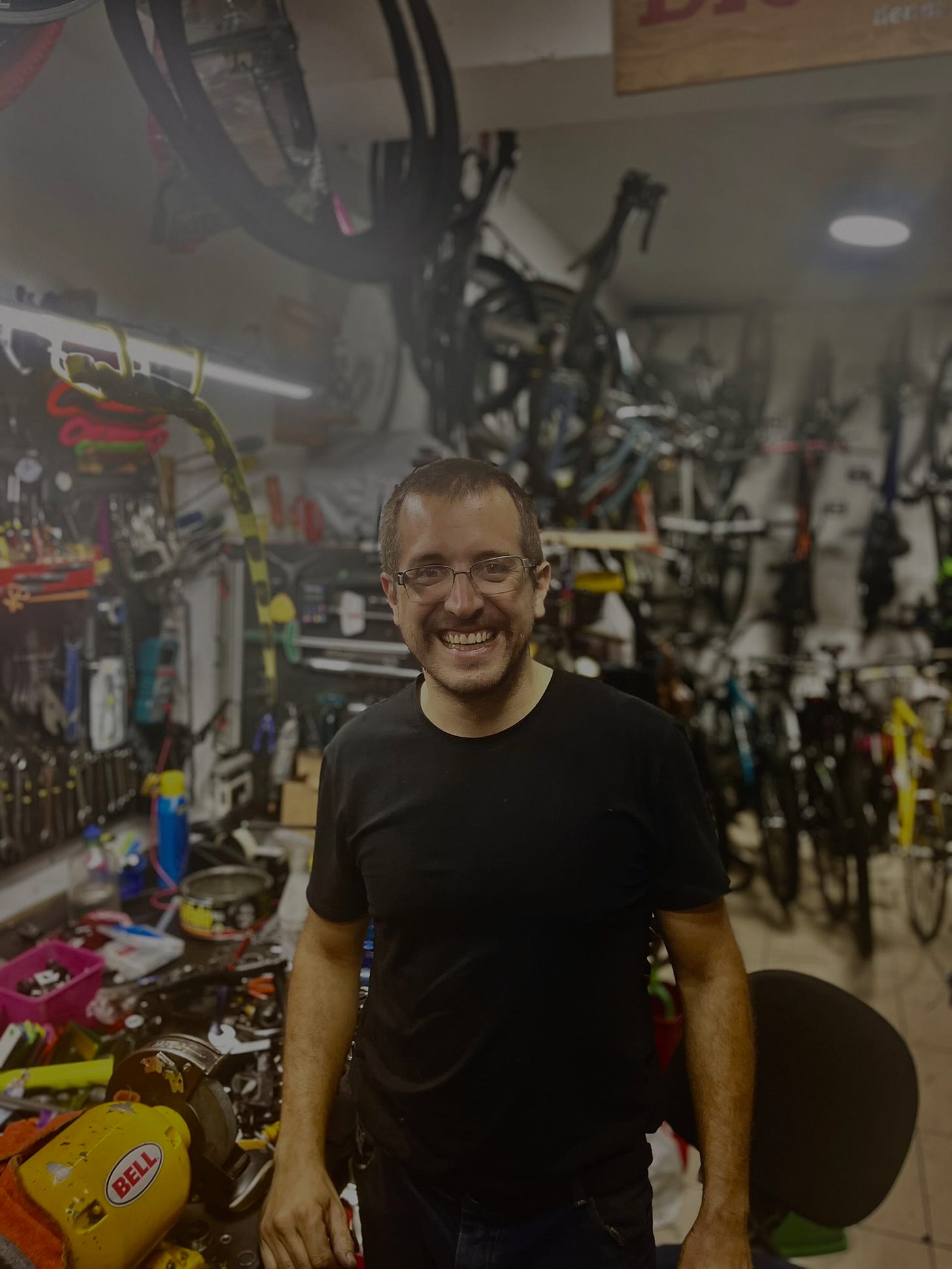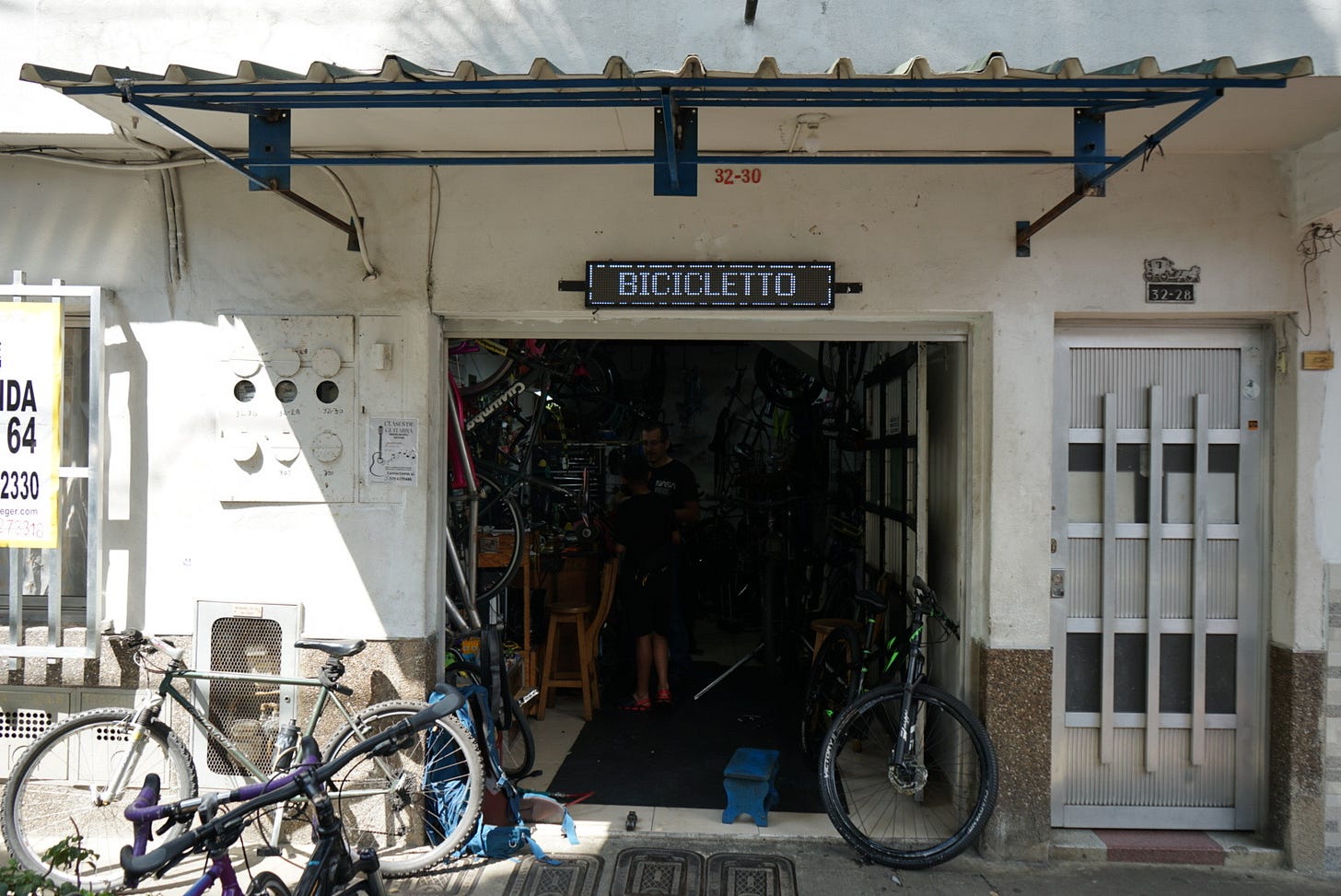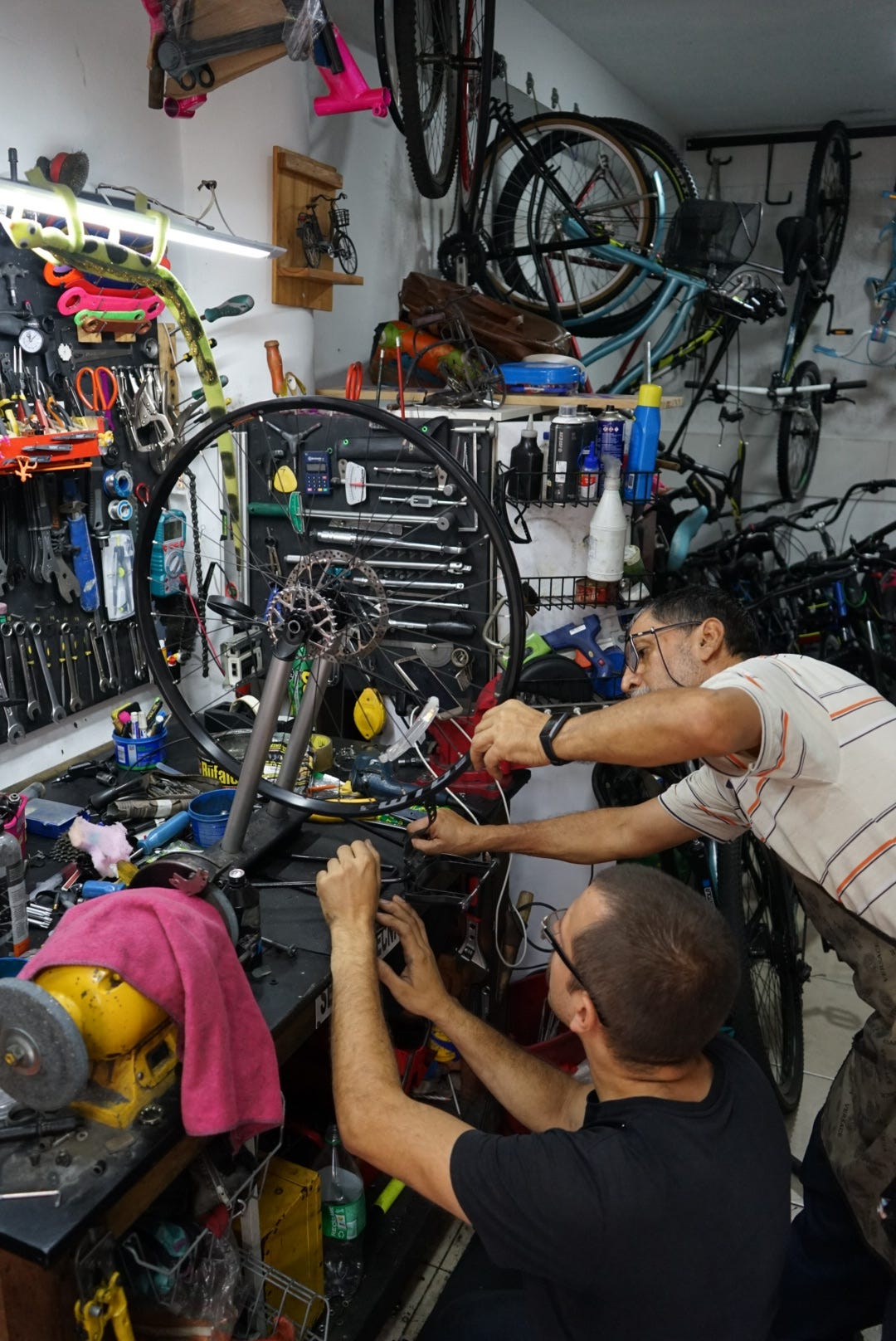Tomás Isaza: "For me, it is the best race there is"
A Bike Shop, a Race, and One Mechanic’s Fight for Community
This is the third (and final) “In their own words” article from Envigado — our home before we set out for this adventure. Check out the stories with Orlando Restrepo and Esperanza Murillo here.
In his own words:
My name is Tómas Isaza – I’m a bike mechanic and the owner of Bicicletto.
I used to work as a fly operator. This was about 15 years ago, and I would work in theaters, rigging actors with ropes to lift them and bring them down.
But at home, I had a great collection of tools even then. Not all I have now – but I had good tools and I had my bikes. I loved working on them, and my friends would come to me if they needed help too.
Sometimes, the man I worked for rigging actors just wouldn’t pay. So one day, when he failed to pay me, I quit.
I had some savings, so I decided to give working on bikes a try. But I ran out of money. So, I went to a local bike workshop, Ciclomarino, and asked if they needed a mechanic.
They said no. “But,” they told me, “you have your own tools, right? Go work on the street and leave us your phone number in case someone needs help.
I took my tools and pump to the local sportsfield. Back then, the ciclovía1 ran through there and it went well.
I worked on the street for a year until the brother of Ciclomarino's owner offered me a job in another bike shop.
I learned a lot there, but I wasn’t allowed to use my own tools. By the time I left two years later, I didn’t have them anymore.
I started a little business – selling knick-knacks out of a cart in downtown Medellín. I had all kinds of stuff and it all cost 100 pesos. I became kind of a local celebrity, but I missed working on bikes.
I did that for seven years. Then, I met a lady who was making sandals by hand. And I told her that I was really impressed with her work and that I had been a mechanic but that I no longer had the tools. She told me: 'What's important is the craft. Go back to getting your tools. Every time you have three thousand pesos, buy a wrench.'
I started buying wrenches one by one. That's why they're all different brands. Little-by-little, I started rebuilding my collection and even getting some work as a mechanic again. One day, I went to a bike shop to get a part. It was full of clients, so I started helping out. “Look here,” I told one of the customers, “your bike needs new breakpads. I’ll help you.”
When I went back later for another part, the owner pulled me aside: “Why don’t you come work for me?” he said. I was there for a year and a half.
I even got invited to a course by Shimano.2 There was this Japanese man there. The man didn’t speak a word of Spanish, but others told me he was an engineer for Shimano, so I latched on to this guy and didn’t let go.
He went for lunch and I went with him. He told me - although I don’t know how because we didn’t speak each other's language - that a mechanic should not be hidden.
“In a bike workshop, the mechanic should be front and center,” he said. “The mechanic should shine, be with the customer, see the customer, advise the customer on what they need.The bicycle is what it is because of the person who rides it. It doesn’t matter if the bike works perfectly if it’s not personally adapted to each individual.”
That really resonated with me because the shop where I worked was one of those where they hide the workshop behind the showroom.
And I thought, I need a place where I can serve people like I did when I was working on the street, but even better. I need my own shop. So I quit.
I spotted this place while riding in a taxi.
I didn't have a penny, but I said: 'I'm going to set up here.' I started with nothing, working day and night. Three months later, we were up and running.
That was the first of January 2020. Then the pandemic hit. Everthing closed. Except me. I couldn’t afford to.
Delivery workers came because I was the only place open. It was so busy that the mechanic I contracted and I would work until two in the morning and start again early the next day. It was impressive, the amount of work.
That’s around when I started organizing the race – the Vuelta a la Magnolia,3 but it wasn’t called that, it didn’t have a name. It all started because I had this bike – the kind everyone has – a delivery bike with a basket on it. And everyone wanted to race against that bike and, most of the time, I won.
It was an informal race, the track was just a one-kilometer sprint in a single lap around La Magnolia. But it was hard – you would finish exhausted.
At first, someone would come by and ask to race and we’d go around the track. But then, one day, four people came at once looking to race. I closed the shop and we went around.
From then on, we started getting together every Thursday at the same time. The excitement was unparalleled. For me, it's the best race there is. I've done others, but none are like this one. The route is exciting, neither too long nor too short, neither easy nor difficult.
Races are an incredible way to improve. There was a kid, nicknamed Honguito, who at age 11 would finish last. But he kept racing, and in one of the last races, he won. That's what I want: for children to fight, to improve, to challenge themselves. It's beautiful.
A year ago, we made it an official race. There weren't as many cars then, but that has changed – in just one year that has changed a lot. More and more cars began driving around here.

Once, I had an accident during a race. A guy was crossing the street, looking the other way. Someone else shouted for him to watch out, but instead of moving to one side he started jumping from side to side – I couldn’t pass him because he was dancing around.
I didn’t hit him with the bike but only because I slammed on the breaks. I went flying off the bike and we fell together. I was pretty scraped up, but he was fine. The bike was destroyed. I came out of it afraid to race again.
Then the next week there was another race. No one got hurt that time, but they almost did. I was in the lead again with another cyclist catching up… and then a motorcycle came out of nowhere. He just didn’t break at all. We – all three of us – almost had a head-on collision.
So I said, for now, we have to stop. I think it's the best race in the world, but until it's safe, we have to stop. If something happens to me, fine, but I don't want anything to happen to anyone else, especially the children.
That's why I suspended the race - I don't want it to end tragically. I would love for it to return with support from the mayor's office, even if just once or twice a year.
Cars have these roads every day. Why can’t we have them once in a while?
On Sunday, Medellín closes major roads for motorized traffic so people can safely walk, run, and cycle.
Big bicycle components brand
Name of the neighborhood Tomás’ bikeshop is in.







